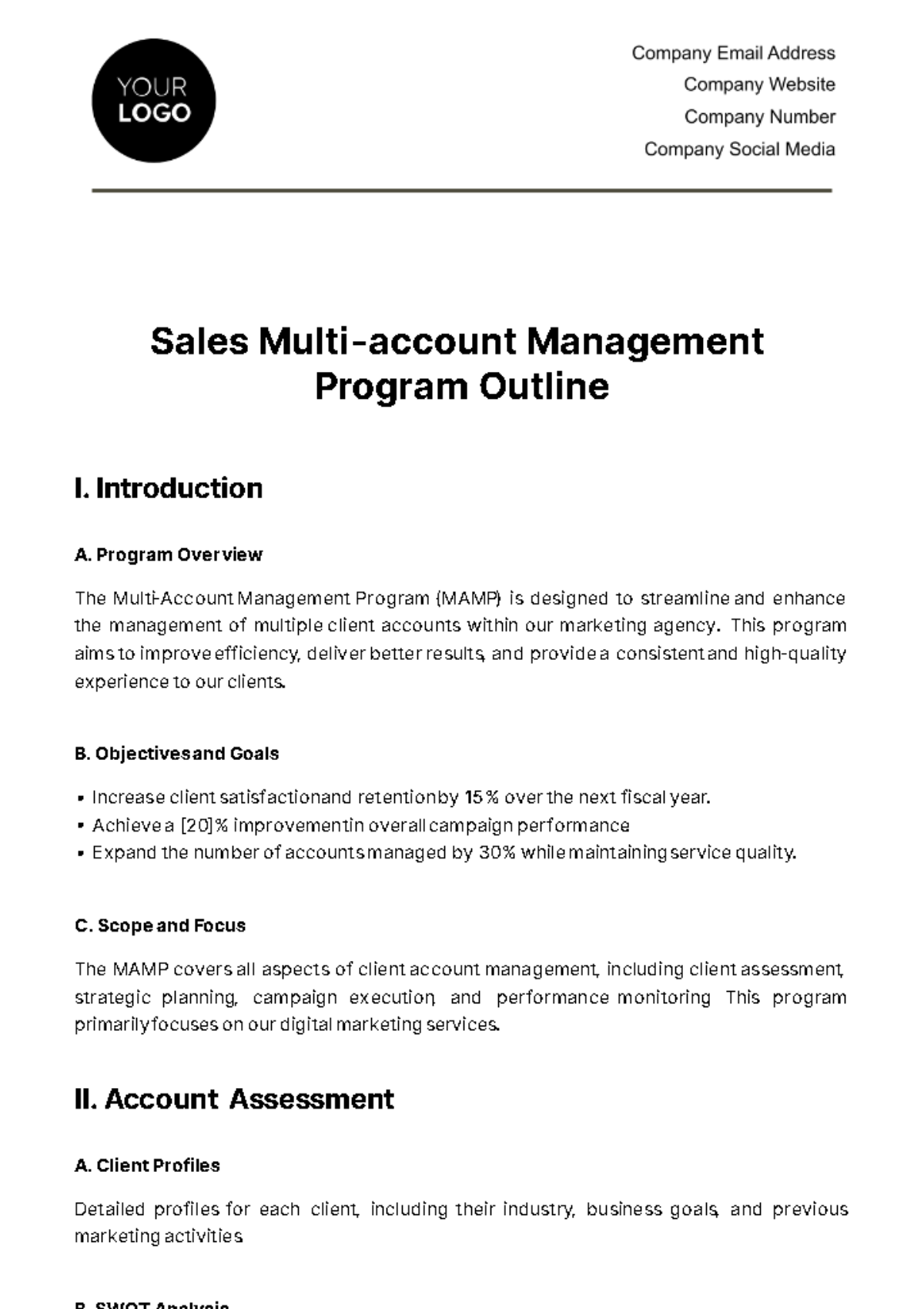Free Sales Multi-account Management Program Outline

I. Introduction
A. Program Overview
The Multi-Account Management Program (MAMP) is designed to streamline and enhance the management of multiple client accounts within our marketing agency. This program aims to improve efficiency, deliver better results, and provide a consistent and high-quality experience to our clients.
B. Objectives and Goals
Increase client satisfaction and retention by 15% over the next fiscal year.
Achieve a [20]% improvement in overall campaign performance.
Expand the number of accounts managed by 30% while maintaining service quality.
C. Scope and Focus
The MAMP covers all aspects of client account management, including client assessment, strategic planning, campaign execution, and performance monitoring. This program primarily focuses on our digital marketing services.
II. Account Assessment
A. Client Profiles
Detailed profiles for each client, including their industry, business goals, and previous marketing activities.
B. SWOT Analysis
Analyzing the strengths, weaknesses, opportunities, and threats for each client to inform strategy.
C. Key Performance Indicators (KPIs)
Identifying and defining KPIs relevant to each client's unique goals.
D. Competitor Analysis
In-depth analysis of the client's competitors to identify market opportunities and challenges.
III. Strategy Development
A. Account Segmentation
Categorizing clients into distinct segments based on industry, size, and marketing objectives.
Tailoring strategies to address the specific needs of each segment.
B. Target Audience Definition
Creating detailed buyer personas for each client to guide content and campaign targeting.
C. Messaging and Positioning
Crafting unique value propositions and messaging for each client.
Ensuring consistent branding and positioning across all marketing materials.
D. Content Strategy
Developing a content calendar that aligns with client goals and target audiences.
Incorporating various content formats, including blog posts, social media, and email marketing.
E. Campaign Planning
Designing comprehensive campaign plans, including channel selection, budget allocation, and creative concepts.
Aligning campaigns with client-specific KPIs and milestones.
IV. Implementation Plan
A. Team Allocation
Assigning dedicated account managers and specialists to each client.
Defining roles and responsibilities for the team.
B. Budget Allocation
Allocating budget resources based on the client's goals and the proposed campaign plans.
Ensuring cost-effectiveness and ROI.
C. Tools and Resources
Listing the necessary marketing tools, software, and platforms for campaign execution.
Identifying additional resources or training requirements for the team.
D. Timeline and Milestones
Creating a project timeline with key milestones, campaign launch dates, and performance review points.
Aligning the timeline with client expectations and objectives.
V. Execution and Monitoring
A. Campaign Launch
Detailed plan for launching campaigns, including content publishing schedules and ad placements.
Quality assurance processes to ensure error-free execution.
B. Performance Tracking
Real-time monitoring of key performance metrics, such as website traffic, lead generation, and conversion rates.
Setting up dashboards and automated reporting tools for ongoing tracking.
C. A/B Testing
Implementing A/B tests to optimize campaign elements, including ad copy, landing pages, and email subject lines.
Regularly reviewing test results and making data-driven adjustments.
D. Adjustments and Optimization
Continual assessment of campaign performance against KPIs.
Implementing changes and optimizations to improve results based on data analysis.
VI. Reporting and Analysis
A. Regular Reporting
Weekly, monthly, and quarterly reports for clients, summarizing campaign performance and progress.
Customized reporting templates for each client.
B. ROI Analysis
In-depth analysis of return on investment (ROI) for each client, including cost-per-acquisition (CPA) and return-on-ad-spend (ROAS) calculations.
Recommendations for ROI improvement.
C. Recommendations
Providing insights and actionable recommendations based on campaign data and analysis.
Proposing adjustments and new strategies for achieving client goals.
- 100% Customizable, free editor
- Access 1 Million+ Templates, photo’s & graphics
- Download or share as a template
- Click and replace photos, graphics, text, backgrounds
- Resize, crop, AI write & more
- Access advanced editor
Streamline multi-account management with the Sales Multi-account Management Program Outline Template brought to you by Template.net! This customizable outline provides a structured approach to handling multiple accounts. Leverage the editable features and the AI Editor Tool to tailor the program outline to the specific needs of each account. Edit today!





























